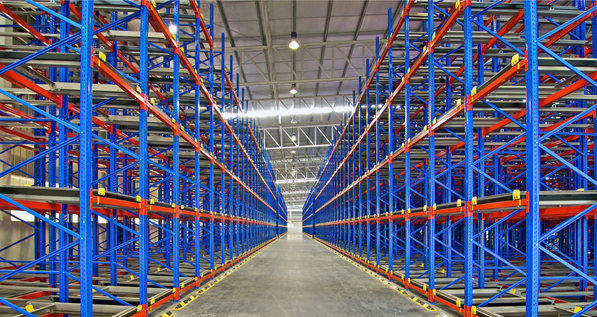Pallets are one of the most popular options for packaging and storage, servicing a broad category of industries due to the efficient handling they offer. A pallet racking system is a storage solution developed to suit these structural foundations. Thanks to the popularity of pallets, this type of racking is one of the most commonly used in warehouses across Australia. Think of pallet racks as open shelves where you can stack load upon load. If you run a warehouse with pallet loads, pallet racking is available in different configurations to suit your needs. Your specific storage requirements will help to determine whether you should get a single or multi-level system.
A pallet rack consists of these main parts:
- Upright frames − Also called columns, the vertical frames are the backbone of the racking system. They differ in design and size according to different purposes. The columns have holes and slots where the load beams link.
- Braces − These are diagonal or horizontal beams bolted or welded between two columns to form the larger frame.
- Footplates − Pads attached to the end of the upright columns to anchor the rack to the floor, helping to increase stability.
- Load beams − Supports that are laid out horizontally on the frame to provide surface area for storage. They attach securely over the upright frames for adjustable heights.
H2: How They Maximise Storage Space
The most significant advantage that pallet racks have over other systems is their efficient use of space. In warehouses, space is a precious commodity. The more room you have, the more inventory you can store. Businesses are always looking for ways to get more space in their warehouses. One solution is to build an extension, which means spending more money. The next best thing is to install pallet racking. This type of racking system has loading spaces stacked on top of one another. The set-up uses minimal floor space, allowing you to have as many frames as possible.
When storing loads, pallets can be stacked to the maximum height. You can also arrange the racks to leave enough floor space for cranes and other loading equipment. The organisation of loads is easy with pallet racking, as they allow you to store more. This efficient use of space translates to cost-savings that reflect positively on your bottom-line. It’s additionally easy for workers to access loads in pallet racking systems due to the open shelving system.
H2: Common Pallet Racking Systems
Not all pallet racks are the same, with some designs being more popular than others. A selective rack system supports the first in, first out (FIFO) system. The set-up forms aisles where trucks and cranes can move easily. This is suitable when you require unobstructed access to pallets. Double deep racking mode is a first in, last out system that has guard rails to support the pallets at the top. These racks are suitable when you have more pallets and need deep storage densities. Mobile racking is where the base has wheels to move the system as required, and one aisle opens at a time. This racking mode is perfect for areas with high building and operating expenses, such as cold stores, as it provides a high degree of storage.


Comments are closed.